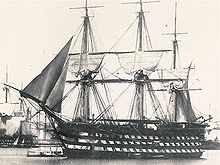Océan class
| This article was entered on the quality assurance page of the portal: shipping due to significant defects . Articles that are not significantly improved can be deleted if necessary. Please help to correct the deficiencies in the content of this article and participate in the discussion . |
|
Model of an Océan-class ship of the line (Marseille Musee de Marine)
|
||||||||||||||||
|
||||||||||||||||
|
||||||||||||||||
|
||||||||||||||||
|
||||||||||||||||
The Océan class (or Commerce de Marseille class ) was the heaviest class of ships of the line in the French Navy , designed as 118-gun, three- decker ships. The designs are mainly based on the engineer Jacques-Noël Sané . Fifteen units were completed from 1788, the last of which entered service in 1854. A sixteenth was never completed and four more were never launched. Commerce de Marseille is the first ship of the series to go at sea. The États de Bourgogne , however, was ordered much earlier. This is why the États de Bourgogne (later renamed Océan ) is the type ship in English-language literature and partly also in French-language literature .
Building history
The first two ships in the Océan series were the Commerce de Marseille and Etats de Bourgogne in the late 1780s. Three ships of the same design followed in the 1790s (another four, ordered between 1793 and 1794, were never built). A second group of eleven units was ordered during the Empire ( Napoleon Bonaparte ); some of the later ships were only designated as the Austerlitz class after the end of the Napoleonic era . A pared-down, shortened version of this design, the Commerce-de-Paris class with only 110 cannons, was later produced, two of which were completed.
With a displacement of 5,095 tons and 118 cannons, this type of ship was the largest ever built. Great Britain , the largest of the Naval Nations, had not built particularly large ships of the line until 1790 . France ushered in a new phase of shipbuilding with the Océan class. Together with the 74-gun ships of the Téméraire type and the 80-gun ships of the Tonnant type , the Océan 120-gun ships were to become one of the three standard French ships of the line in the war years 1793 to 1815. They were the most powerful ships of the Napoleonic Wars and a total of ten served during that time. However, these ships were expensive in terms of building materials, artillery, and crew and were therefore reserved for admirals as the flagships of their fleet. Some of the ships spent 40 years in service and were still in service in 1860, three of them were fitted with auxiliary steam engines in the 1850s.
design
The design for the first 118-cannon three-decker warships was created in 1782 based on a design by shipbuilder Antoine Groignard . With an additional pair of cannons on each deck (including the quarterdeck ), the firepower of these capital ships increased from 110 to 118 cannons, including 32 36-pounder cannons in the lower cannon deck. The French Navy ordered two of them to be built in Toulon and Brest. The shipbuilder tasked with building the latter ship was Jacques-Noël Sané.
However, with the beginning of peace after the end of the American Revolutionary War , these two ships were canceled along with several others in 1783. The concept was revived in 1785 when Sané worked with Jean-Charles de Borda to develop the design of the Commerce de Marseille , which marked an advance in the evolution of ship design. The hull was laid out simply with straight horizontal lines, minimal decorations and slopes. The quarterdeck was almost an integral part of the railing , and the forecastle was minimally developed.
The ships were extremely successful as gun platforms and sailors. In the past, ships that were only half the size of the Océan ships were brought into port before the autumn storms and were considered very unwieldy.
The first two units of the Océan class seemed to have been less powerful than needed: the Commerce de Marseille , captured by the British in 1793 , was used by them as a storage ship. The second ship, the Océan, was extensively rebuilt over a decade. This suggests that the growth in size of wooden warships created structural problems that were only gradually resolved.
Although these ships were costly, with the introduction of a second (modified) group in 1806, their design changed in terms of total tonnage to become even larger. 18 pounder guns were installed on their upper deck . Until then, French three-deck ships had a maximum of 12 pound cannons. The Austerlitz formed in 1805, the lead ship for the Océan class.
Ship list
| Surname | shipyard | Keel laying | Launch | Decommissioning | Whereabouts |
|---|---|---|---|---|---|
| Commerce de Marseille | Toulon , naval shipyard | 1786 | 1788 | 1793 | 1793 British booty, 1799 prison wrecked 1802 |
| Etats de Bourgogne (from 1793 Montagne , short Peuple , 1795 Ocean ) | Brest , naval shipyard | 1786 | 1790 | 1854 | Sold in 1855 |
| Dauphin Royal (from 1792 Sans Culotte , 1795 Orient ) | Toulon, naval shipyard | 1790 | 1791 | 1798 | 1798 explodes in the naval battle of Aboukir |
| Republique Francaise (from 1803 Majestueux ) | Rochefort , naval shipyard | 1794 | 1802 | 1839 | Wrecked in 1839 |
| Vengeur (from 1793 Peuple , 1794 Vengeur , 1805 Imperial ) | Brest, naval shipyard | 1793 | 1803 | 1806 | Damaged in 1806 and boarded during the battle of Santo Domingo, then destroyed by fire |
| Fleurus | Toulon, naval shipyard | just ordered, never built | |||
| Quartorze Juillet | Toulon, naval shipyard | just ordered, never built | |||
| Liberte des Mers | Brest, naval shipyard | just ordered, never built | |||
| Republicain | Rochefort, naval shipyard | just ordered, never built | |||
| Austerlitz | Toulon, naval shipyard | 1806 | 1808 | 1821 | Wrecked in 1837 |
| Marengo (from 1808 Marengo , 1807 ville de Vienne , 1814 Comte d'Artois , 1830 Ville de Paris ) | Rochefort, naval shipyard | 1808 | 1850 | 1882 | Wrecked in 1898 |
| Monarquel (from 1810 Wagram ) | Toulon, naval shipyard | 1809 | 1810 | 1836 | Wrecked in 1837 |
| Imperial (from 1814 Royal Louis , 1815 Imperial , 1815 Royal Louis ) | Toulon, naval shipyard | 1810 | 1811 | 1825 | Wrecked in 1825 |
| Montebellol | Toulon, naval shipyard | 1810 | 1812 | 1867 | Wrecked in 1889 |
| Tonnant (from 1828 Louis XIV ) | Rochefort, naval shipyard | 1811 | 1854 | 1873 | Wrecked in 1882 |
| Sans Pareil (from 1812 Roi de Rome , 1812 Inflexible , 1812 Sans Pareil ) | Brest, naval shipyard | 1811 | Broken down on the slipway in 1816 | ||
| hero | Toulon, naval shipyard | 1812 | 1813 | Wrecked in 1828 | |
| Inflexible (from 1820 Duc de Bordeaux , 1830 Friedland ) | Cherbourg , naval shipyard | 1812 | 1840 | 1864 | Wrecked in 1879 |
| Sovereign | Toulon, naval shipyard | 1813 | 1819 | 1867 | Broken down in 1905 |
| Formidable (from 1823 Trocadero ) | Toulon, naval shipyard | 1813 | 1824 | Accidentally destroyed by fire in 1836 |
Web links
- Three decks
- Vaissaux de ligne français de 1682 à 1780 1. Association de Généalogie d'Haïti
- Les vaisseaux à trois ponts français au XVIIIe siècle.
- Navy premiere empire
literature
- Rif Winfield & Stephen S. Roberts: French Warships in the Age of Sail 1786-1861 . Seaforth Publishing, 2017, ISBN 978-1-4738-9351-1 .
- Roche, Jean Michel: Dictionnaire des batiments de la flotte de guerre francaise de Colbert a nos jours 1 1671-1870 p.223 . 1671-1870. Group Tetozel-Maury Millau, ISBN 978-2-9525917-0-6 .
- Alain Demerliac: Nomenclature des navires francais de 1715–1774 . edition omega, Nice 1995, ISBN 2-906381-19-5 .
- Alain Demerliac: La Marine du consulat et du Permier Empire . Nomenclature des Navires Francais de 1800 a 1815. Editions Ancre, 2004, ISBN 2-903179-30-1 .
- Alain Demerliac: La Marine de la Restauration et du Louis-Philippe 1er . Nomenclature des Navires Francais de 1815 a 1848. Editions Ancre, 2004, ISBN 2-906381-23-3 .
- Alain Demerliac: La Marine de la Deuxieme Republique et du Secon Empire . Nomenclature des Navires Francais de 1848 a 1871. Editions Ancre, 2004, ISBN 2-906381-23-3 .
Individual evidence
- ↑ Le vaisseau de 118 canons type Sané L'Océan. July 12, 2010, accessed August 25, 2019 .







